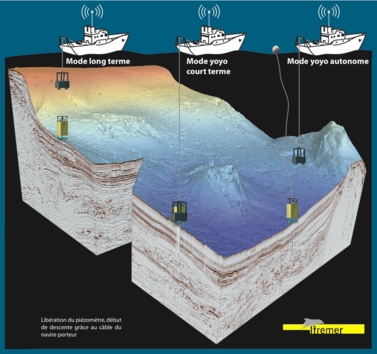Piezometer
Monitoring interstitial overpressure in ocean sediment
The role of the submarine slope on mechanical instability is secondary relative to external mechanisms such as a high sedimentation rate, earthquakes, the thermal gradient, thermodynamic instability of gas hydrates, and fluid expulsion from deep reservoirs which may increase pore pressure in ocean sediment.
These external mechanisms generally result in interstitial overpressure. In low permeable sediment (clay or silt clay), dissipation of interstitial overpressure is prolonged. The consequences of this overpressure and slow dissipation can be a decrease or even absence of effective stress inducing instabilities on low slopes by a loss of shear resistance along the fracture surfaces. Measuring pore pressure in ocean sediment is therefore fundamental for:
- Understanding observed instability mechanisms (pockmarks, hydrofracturing, fault blocks, etc.);
- detection processes inducing interstitial overpressure (thermal gradient, dissociation of gas hydrates, earthquakes, etc.).
- assessing slope instabilities. Adequate calculation of slope stability cannot be carried out without measuring interstitial overpressure;
- In-situ measurements of the hydraulic parameters of undisturbed sediment (permeability, consolidation coefficient, etc.)
Ifremer has developed a differential piezometer that provides long-term measurements (up to two years) of interstitial overpressure at a depth of 15 metres.
Two types of measurements can be made with this piezometer:
- Determining the hydraulic parameters of sediment from the dissipation of pore pressure generated by the piezometer;
- Identifying and quantifying hydraulic gradients in sedimentary layers
The three deployment modes
Long-term mode:
The piezometer is autonomous for up to two years (the tip is lost).
This deployment mode detects processes that induce interstitial overpressure (dissociation of gas hydrates, earthquakes, fluid migration, etc.)
Short-term yoyo mode:
The piezometer remains connected to the boat via the launching cable. The equipment is recovered at the end of the measurement (8 to 24 h).
This mode determines the hydraulic parameters of the sediments from the dissipation of pore pressure generated by the piezometer. It also identifies and quantifies hydraulic gradients in sedimentary layers.
Autonomous yoyo mode:
This new deployment mode allows short-term measurements to be made at depths down to 1500 m. The equipment is recovered at the end of the measurement (1 to 10 days).










